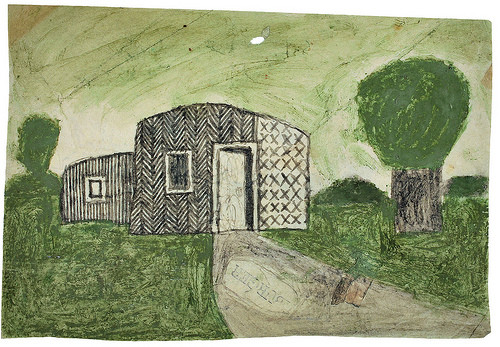James Castle
18 May - 05 Sep 2011
JAMES CASTLE
Show and Store
Curator: Lynne Cooke
18 May – 5 September, 2011
Born in the State of Idaho in 1899, James Castle lived in isolation from the art world until his death in 1977. His artistic production, composed mostly by drawings made with soot and saliva, coloured cardboard constructions with strings attached and handmade books, have no titles, dates or any other indication of a chronology. The questions arising from his heterodox technique and the alteration of the tools of artistic classification are underlined by the fact that he never gave a single interview or made any comment that served to clarify his work.
Castle's enormous artistic production was conserved thanks to his careful and obsessive perseverance, which is somewhat surprising in an artist that showed very little interest in the world of professional art. Recognition came in the 1990s, in connection with notions such as marginal art, although such notions often highlighted biographical details more than the characteristics of his work. His personality, his deafness and the fact that he was practically illiterate were important factors in the attention focused on him as a primitive-naïve artist from the middle of the twentieth century. However, his work reflects special interest in the possibilities of contemporary visual representation: his tendency to use outlines and the design of his drawings, the sinister dimension of his objects which are both ordinary and strange, or his interest in representing architectural fragments as if they were projections of the human body, reveal qualities that are quite alternative to the visual scheme prevailing in the second half of the twentieth century.
Similarly, one of the most important qualities of Castle's work is the presentation that he himself made of his work in improvised spaces, such as abandoned silos, where he arranged the works using an informal organisation system, to be viewed by family and guests. The arrangement of the pieces in familiar spaces was also the object of some of his drawings and such drawings indicate that the theatricality of visual representation was an extremely important matter in his work. Curiously enough, this coincides with the interests shown by the most advanced tendencies of the times, such as minimalism.
The impulse to show and store in the case of this artist becomes a central theme for this exhibition, which displays a determination to go beyond the mythical projection that an artist like James Castle had.
Show and Store
Curator: Lynne Cooke
18 May – 5 September, 2011
Born in the State of Idaho in 1899, James Castle lived in isolation from the art world until his death in 1977. His artistic production, composed mostly by drawings made with soot and saliva, coloured cardboard constructions with strings attached and handmade books, have no titles, dates or any other indication of a chronology. The questions arising from his heterodox technique and the alteration of the tools of artistic classification are underlined by the fact that he never gave a single interview or made any comment that served to clarify his work.
Castle's enormous artistic production was conserved thanks to his careful and obsessive perseverance, which is somewhat surprising in an artist that showed very little interest in the world of professional art. Recognition came in the 1990s, in connection with notions such as marginal art, although such notions often highlighted biographical details more than the characteristics of his work. His personality, his deafness and the fact that he was practically illiterate were important factors in the attention focused on him as a primitive-naïve artist from the middle of the twentieth century. However, his work reflects special interest in the possibilities of contemporary visual representation: his tendency to use outlines and the design of his drawings, the sinister dimension of his objects which are both ordinary and strange, or his interest in representing architectural fragments as if they were projections of the human body, reveal qualities that are quite alternative to the visual scheme prevailing in the second half of the twentieth century.
Similarly, one of the most important qualities of Castle's work is the presentation that he himself made of his work in improvised spaces, such as abandoned silos, where he arranged the works using an informal organisation system, to be viewed by family and guests. The arrangement of the pieces in familiar spaces was also the object of some of his drawings and such drawings indicate that the theatricality of visual representation was an extremely important matter in his work. Curiously enough, this coincides with the interests shown by the most advanced tendencies of the times, such as minimalism.
The impulse to show and store in the case of this artist becomes a central theme for this exhibition, which displays a determination to go beyond the mythical projection that an artist like James Castle had.

